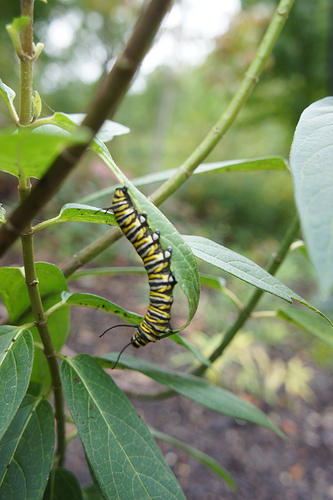Some folks may see a caterpillar in their garden and think “I need to kill it” or “I think there’s a chemical to treat those.” At Crystal Bridges, we see a caterpillar and think “All right! It’s working!” There are two questions that I ask myself before selecting a plant to add to our living collection: #1 – What sort of interest (bloom, interesting foliage) does this plant give us? And #2 – What kind of environmental impact will this plant have on our local ecosystem (i.e. is this a host plant for a butterfly? Does it produce berries for wildlife?) We planted Spicebush to attract the Spicebush Swallowtail, Pawpaw to attract the Zebra Swallowtail (and for the delicious fruit!) and Golden Alexander to attract Black Swallowtail. The most intentional host plant that we have added to our collection is the milkweed (Asclepias sp.).
 We have five species of milkweed in our collection: Butterfly Milkweed (Asclepias tuberosa), Common Milkweed (Asclepias syriaca), Showy Milkweed (Asclepias speciosa), Swamp Milkweed ‘Cinderella’ (Asclepias incarnata ‘Cinderella’) and Four-Leaved Milkweed (Asclepias quadrifolia). The Four-Leaved Milkweed is the only species that existed on our site prior to construction. We have added close to two hundred specimens and I plan on adding more! The milkweed is important because it is the only host plant that Monarchs feed on. Unfortunately, we have seen a severe decrease in the Monarch population. Experts believe it is due to a decrease in the overwintering grounds (Oyamel Fir forest) in the mountains of Mexico, as well as a decrease in their host plant. (To learn more about the habitat loss, visit http://www.npr.org/2013/04/12/177029257/monitoring-the-monarchs). Without milkweed, we lose the Monarch butterflies. It is up to us to help restore the milkweed population, thus helping restore the Monarch population!
We have five species of milkweed in our collection: Butterfly Milkweed (Asclepias tuberosa), Common Milkweed (Asclepias syriaca), Showy Milkweed (Asclepias speciosa), Swamp Milkweed ‘Cinderella’ (Asclepias incarnata ‘Cinderella’) and Four-Leaved Milkweed (Asclepias quadrifolia). The Four-Leaved Milkweed is the only species that existed on our site prior to construction. We have added close to two hundred specimens and I plan on adding more! The milkweed is important because it is the only host plant that Monarchs feed on. Unfortunately, we have seen a severe decrease in the Monarch population. Experts believe it is due to a decrease in the overwintering grounds (Oyamel Fir forest) in the mountains of Mexico, as well as a decrease in their host plant. (To learn more about the habitat loss, visit http://www.npr.org/2013/04/12/177029257/monitoring-the-monarchs). Without milkweed, we lose the Monarch butterflies. It is up to us to help restore the milkweed population, thus helping restore the Monarch population!
Four generations of Monarchs emerge each year. The generation of Monarchs that we are seeing now on our milkweed is the fourth. This generation will migrate around 2,500 miles to its overwintering location in Mexico! Even more amazing is the fact that this generation has never even been to this location, so they are not doing this migration by memory. It seems to be hard-wired into their system. The Monarch migration is a phenomenon that is still not completely understood by researchers. They will stay in Mexico for 6-8 months then migrate back to the northern United States and southern Canada, laying eggs along the way (at least the females will). The eggs hatch after about 4 days, then the caterpillars (the larvae stage) eat until grown, which is about 2 weeks. They set their chrysalis (the pupa stage), then emerge as butterflies around 10 days later. The first three generations of adult butterflies live for 2-6 weeks. The fourth generation (the overwintering ones) lives the longest at 6-8 months. This is simply a remarkable feat for something that weighs less than 1 ounce!
Stop by and visit our Monarch oasis soon, as the caterpillars are growing up fast! It is located on the South Lawn, across the trail from LOVE. Look for the “Monarch Oasis” sign.
Please visit www.monarchwatch.org to learn how you can help the monarchs.







